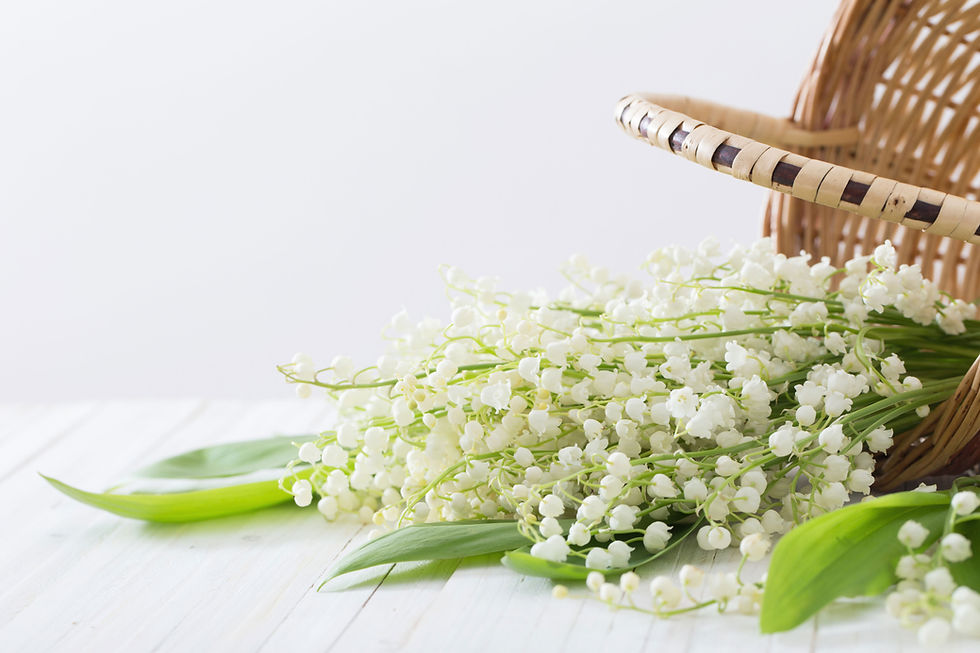Marietta Daisies Garden Club
- mariettadaisies
- 1 day ago
- 3 min read
May Birth Flower
Lily of the Valley

A symbol of purity, joy, love, sincerity, happiness and luck, lily of the valley has much significance beyond the United Kingdom. It's actually the national flower of Finland, and in France, on 1st May for La Fête du Muguet, lily of the valleys are gifted to loved ones.
The Lily of the valley flower looks a little bit like white bells or ballerina skirts, and has a number of personal meanings. Often these woodland bunches are considered a very feminine flower type, and as such are known to represent motherhood, chastity, good luck, sweetness, and purity.
A distinctive, pretty flower it was often noted in poems, such as Song to the Lily of the Valley by Thomas Cowherd. It has also been associated with various folklores, including tales of fairies and nightingales.
Its flowers are thought to bring luck in love and so are very popular in wedding bouquets.
In Christian legend, Eve's tears turned into lilies of the valley as she was expelled fro the Garden of Eden. The flower is also seen as a sign of Christ's second coming and is mentioned fifteen times in the Bible.
This verse from Psalms expresses each day's promise of a return of happiness and a reason to rejoice. Psalms of songs and are among the most poetic verses in the Bible.
Mentioned many times in the Bible, the white lily symbolizes purity, rebirth, new beginninigs and hope and is most often associated with the resurrection of Jesus Christ as observed on Easter.
The lily of the valley means return of happiness in the Victorian language of flowers.
Garden type
Lily of the valley makes a good ground cover plant (you'll quickly have a carpet of May bells in no time), making it ideal for woodland gardens (especially for shady and damp areas) and cottage gardens.
These perfumed bell flowers would work equally well in a scented garden and cut flower patch. It's also ideal for a low-maintenance garden and would be a welcome addition to a shady borders or patio pot. It will thrive under a canopy of trees or in the dappled shade under an established shrub.
When to plant lily of the valley
Lily of the valley requires little maintenance and doesn't need a lot to thrive – just full or partial shade and moist soil.
Its flowering season is from May to June, going from pure white, highly-fragrant bell-shaped blooms, to deep red berries, both of which add interest to the contrasting dark green stem.
Lily of the valley grows from rhizomes called pips that extend their roots underground, spreading horizontally and creating abundant ground cover, often at speed.
It's best grown in a pot indoors before planting out into the garden from May.
Equally, you can buy it ready potted in spring from your local garden centre.
In autumn, you can divide and replant overcrowded colonies. Make sure to apply a generous mulch of composted leaf mould or chipped bark around the base of the plant. Remember, there are two ways to propagate lily of the valley – by seed sown in containers or trays in a cold frame or greenhouse, or by division in autumn.
Is lily of the valley poisonous?
Surprisingly, all parts of this innocent-looking flower are poisonous – the flowers and red berries are toxic if eaten. Lily of the valley contains cardiac glycosides which are gastrointestinal irritants, which could prove harmful or fatal if ingested, so keep away from children and pets.
If ingested, the plant can cause abdominal pain, blurred vision, reduced heart rate, vomiting, diarrhea and skin rashes.
The plant is safe to handle but it's recommended that you wash hands thoroughly after touching them.



Comentários